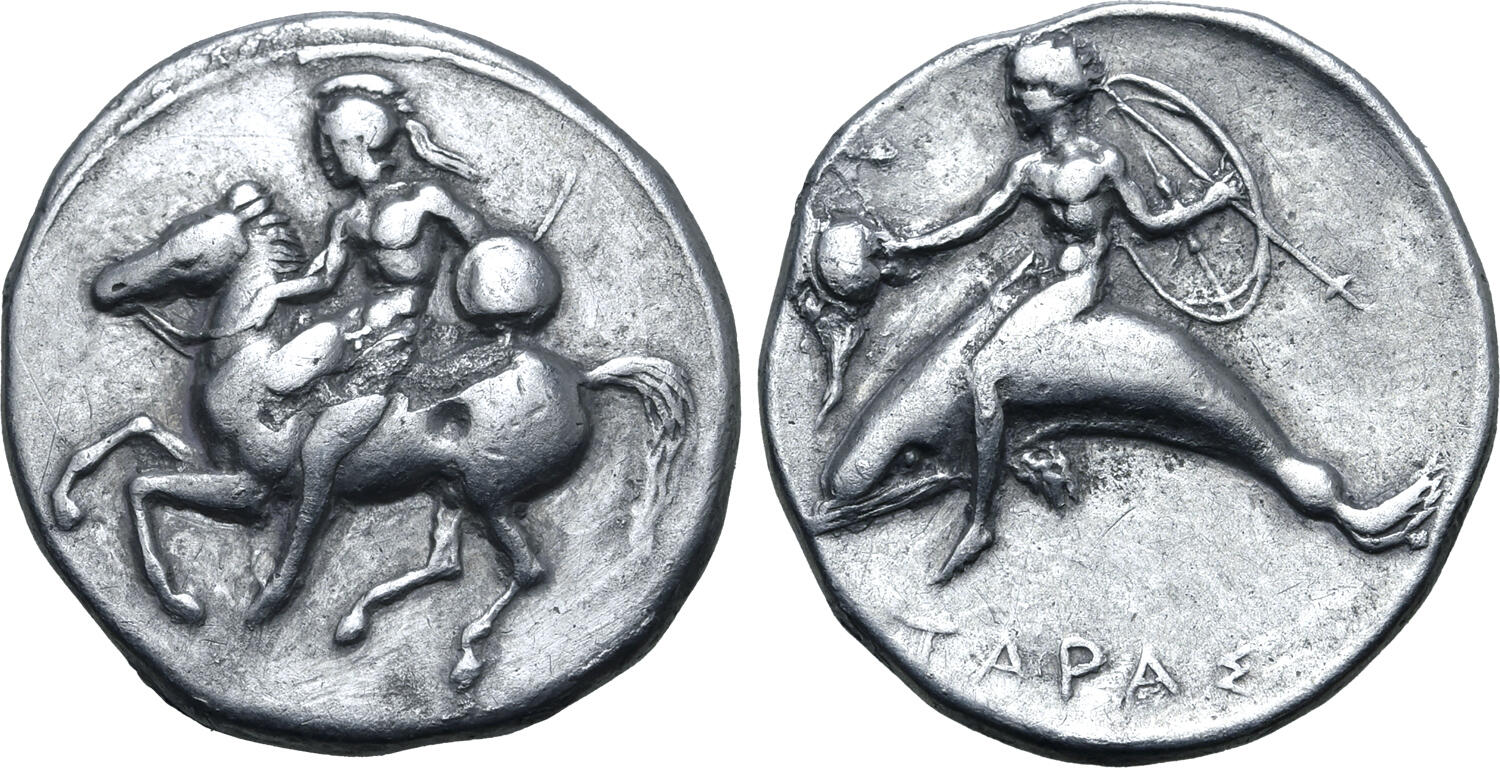Taras, silver, didrachms (415-390 BCE)
From SILVER
415 BCE - 390 BCE Silver 5,773 kg
Description
| ObverseInscription or printing placed on the obverse.: | Nude youth dismounting form horse galloping to left, holding reins, shield and spear |
| ReverseInscription or printing placed on the reverse.: | TAPAΣ (Greek).Taras astride dolphin to left, holding helmet, shield and spear, TAPAΣ below. |
Mint and issuing power
| MintIdentifies the place of manufacture or issue of a numismatic object.: | Taras | Ancient regionAncient region.: | Calabria | Modern countryModern country: Italy | AuthorityIdentifies the issuing power. The authority can be "pretended" when the name or the portrait of X is on the coin but he/she was not the issuing power. It can also be "uncertain" when there is no mention of X on the coin but he/she was the issuing power according to the historical sources: |
Chronology
| FromIdentifies the initial date in a range assigned in a numismatic context. | 415 BCE | toIdentifies the final date in a range assigned in a numismatic context.. | 390 BCE | PeriodTime period of the numismatic object.: Classical 480-323 BC |
Physical description
| MetalThe physical material (usually metal) from which an object is made.: | Silver |
Median weightMedian of the weights of numismatic objects (in grams). in grams | 7.85 | DenominationTerm indicating the value of a numismatic object. Examples: tetradrachm, chalkous, denarius.: | didrachm |
StandardStandard.: |
Image

AC 22 - Taras, silver, didrachm, 415-390 BC.jpg [1]
References
| Die study referencePublication of the study: | Fischer-Bossert 19991Fischer-Bossert 1999, groups 19-26 (varieties 285-369 : O129-O165 et R217-R288). | ||
| Coin series referenceReference to coin series study: | Sear I2Sear I, n° 334-336, RQEMAC3RQEMAC, n° 22, HN Italy4HN Italy, n° 849 | ||
| Coin series web referenceCoin series web references: | |||
Obverse dies distribution
| FrequencyFrequency of specimen in distribution. ᵖ | Number of obversesNumber of obverse dies. ᵖ (o) | % (o) | Number of coinsNumber of coins. (n) | % (n) | Die nameName(s) of the die(s). |
| 1 | 4 | 10.81 | 4 | 0.8 | 136, 146, 161, 163 |
| 2 | 1 | 2.7 | 2 | 0.4 | 129 |
| 4 | 1 | 2.7 | 4 | 0.8 | 156 |
| 5 | 4 | 10.81 | 20 | 4.02 | 132, 141, 144, 155 |
| 7 | 2 | 5.41 | 14 | 2.81 | 140, 145 |
| 8 | 1 | 2.7 | 8 | 1.61 | 138 |
| 9 | 1 | 2.7 | 9 | 1.81 | 151 |
| 10 | 3 | 8.11 | 30 | 6.02 | 143, 149, 160 |
| 11 | 1 | 2.7 | 11 | 2.21 | 159 |
| 13 | 1 | 2.7 | 13 | 2.61 | 162 |
| 14 | 1 | 2.7 | 14 | 2.81 | 147 |
| 15 | 2 | 5.41 | 30 | 6.02 | 130, 131 |
| 16 | 3 | 8.11 | 48 | 9.64 | 134, 150, 157 |
| 17 | 1 | 2.7 | 17 | 3.41 | 153 |
| 18 | 2 | 5.41 | 36 | 7.23 | 133, 152 |
| 19 | 4 | 10.81 | 76 | 15.26 | 137, 139, 142, 158 |
| 27 | 2 | 5.41 | 54 | 10.84 | 135, 148 |
| 30 | 1 | 2.7 | 30 | 6.02 | 154 |
| 32 | 1 | 2.7 | 32 | 6.43 | 165 |
| 46 | 1 | 2.7 | 46 | 9.24 | 164 |
| Total | 37 of 37 | 99.99 | 498 of 498 | 99.99 |
Reverse dies distribution
no distribution is available
Quantification
| Number of obversesNumber of obverse dies. ᵖ (o) | 37 | Number of singletons (o1)The number of singleton coins. ᵖ | 4 |
| Number of reverse diesNumber of reverse dies. (r) | 72 | Number of coinsNumber of coins. (n) | 498 |
| Coins per obverse dieNumber of coins per obverse die. (n/o) | 13.46 | Coins per reverse dieNumber of coins per reverse die. (n/r) | 6.92 |
| Reverse per obverse ratioRatio of obverse dies divided by reverse dies. (r/o) | 1.95 | Percentage of singletons (o1)number of coins (n) divided by the number of singletons (o1) ᵖ | 10.81 % |
| Original number of dies (O) (Carter 1983 formula)The estimation of the number of coins according to Carter 1983 ᵖ | 36.77 | Coins struck if 20,000 as average productivity per dieCoins made if the average productivity for obverses (according to Carter) is 20,000. ᵖ | 735,400 |
| Original number of dies (O) (Esty 2011 formula)The estimation of the number of coins according to the singleton formula in Esty 2011 ᵖ (O) | 39.97 | Survival rate if 20,000 as average productivity per dieSurvival rate if average productivity is 20,000. ᵖ | 0.00068 |
| Coverage (o = % of O) (Esty 1984 formula)Esty 1984 - coverage (% of O) ᵖ (o = % of O) | 99.2% | Die productivity if survival rate 1/2,000Average productivity if survival rate is 1/2,000. ᵖ | 27,087.3 |
| Weight of silver (in kg) if 20,000 coins per die (O = Carter formula)Carter 1983 * Median weight * 20000 (*10 if gold or electrum) ᵖ | 5,773 kg <br /> 5,773 kg | Die productivity if survival rate 1/5,000Average productivity if survival rate is 1/5,000. ᵖ | 67,718.25 |
Remarks
Most likely one single workstation Likely military Group 23 (415-390 BCE) is formed by a unique obverse (O97) first appearing in Group 13 (450-440 BCE)